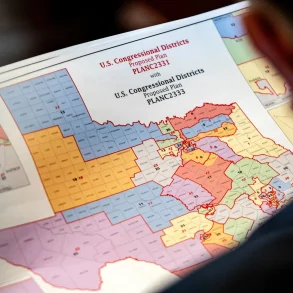Picture this: a state so deep in the hole that it’s begging for a $3.44 billion loan just to keep its healthcare system from collapsing. Now imagine that same state has been quietly siphoning billions of dollars from federal taxpayers—your money—to pay for healthcare for illegal immigrants through a loophole so slick it’s been called “money laundering.” That’s the situation unfolding in California right now, according to a bombshell study from the Economic Policy Innovation Center (EPIC). Authored by Paul Winfree and Brian Blase, the report accuses California of exploiting the Medicaid system, leaving it desperate for cash and sparking a nationwide debate about fairness, immigration, and who should foot the bill. How did California pull this off, and what does it mean for the rest of us?
The Medicaid Loophole: A Step-by-Step Breakdown of California’s Scheme
At the heart of this controversy is Medi-Cal, California’s version of Medicaid, the federal-state program meant to help low-income people with healthcare. Federal law says Medicaid dollars can’t go to illegal immigrants for full coverage, but California’s found a way around that. The EPIC study lays it out plain and simple: “The state of California, colluding with insurance companies who cover Medicaid beneficiaries, has created one of the most outrageous [schemes] yet, a money laundering scheme that results in California obtaining more than $19 billion in federal money without any state contribution over the period from April 2023 through December 2026.”
Here’s how it works, step by step:
- Taxing the Insurers: California hits insurance companies in its Medi-Cal program with a big tax. These aren’t optional fees—insurers have to pay up to keep doing business in the state.
- Paying Them Back: The state takes that tax money and pumps it right back into the insurers’ pockets by boosting their reimbursement rates—the cash they get for treating Medi-Cal patients.
- Grabbing Federal Cash: Since Medicaid is a joint effort, the federal government matches those higher payments, kicking in up to 60% extra. Because California’s jacked up the rates artificially, it scores way more federal dollars than it would otherwise.
- Redirecting the Profits: With all that extra federal money flowing in, California frees up its own budget to spend on stuff federal rules wouldn’t normally allow—like full Medi-Cal coverage for illegal immigrants.
The study doesn’t mince words: “These federal funds leave California with surplus money to spend elsewhere. This scheme effectively allows the state to ‘launder’ federal Medicaid funds without spending any of its own money.” Normally, states have to put up their own cash to get federal support—think of it like matching funds for a school fundraiser. But California’s trick lets it skip that part, raking in billions without dipping into its own wallet. The result? A $19 billion windfall from 2023 to 2026, all courtesy of federal taxpayers.
The Exploding Cost of Healthcare for Illegal Immigrants
California’s decision to open Medi-Cal to illegal immigrants wasn’t cheap—and it’s gotten way pricier than anyone expected. Back in 2020, the state figured it’d cost about $3 billion a year to cover around 1.15 million undocumented residents. Fast forward to 2025, and the Migration Policy Institute estimates 2.74 million illegal immigrants live in California—more than double the original guess. Some think the real number’s even higher, since tracking undocumented populations is tricky.
That population boom has sent costs through the roof. The EPIC study notes, “The cost of covering all California’s illegal immigrants through Medicaid (and not just the January 2024 expansion to those ages 25 to 49) is much more expensive than initially projected.” For the 2024-2025 fiscal year alone, California’s on track to spend $9.5 billion on their healthcare—triple the $3 billion they planned for. Where’s that money coming from? The study ties it straight to the loophole: “Coincidentally, this is how much funding California has generated since 2023 from the federal government as a result of their enhanced Medicaid insurer laundering scheme.”
Meanwhile, the state’s hit a wall. Governor Gavin Newsom’s administration recently told lawmakers it needs a $3.44 billion loan to keep Medi-Cal afloat through March 2025, according to POLITICO. That’s the max the state can borrow under its rules, and H.D. Palmer, a Department of Finance spokesman, admitted it’s just a Band-Aid: “It will only be enough to cover bills for Medi-Cal through the end of March.” After that? Good luck. California’s spending spree has left it scrambling, and the loan’s proof the state can’t keep up with its own promises.
Who’s Getting Hurt—and Who’s Getting Rich?
This isn’t just a California problem—it’s hitting taxpayers everywhere. The EPIC study warns, “This scheme enriches insurers, attracts illegal immigrants to the United States, and adds mountains to the federal debt, all at the expense of working Americans.” Every dollar California pulls from the federal pot is a dollar that could’ve gone to schools, roads, or healthcare for legal residents across the country. Instead, it’s padding the state’s budget and big insurers’ profits. Those higher reimbursement rates don’t just fund care—they line the pockets of companies happy to play along.
Then there’s the immigration angle. Critics say California’s generous benefits—free healthcare you can’t get in most states—act like a magnet, pulling more illegal immigrants across the border. The study backs that up, arguing the loophole “incentivizes illegal immigration” by offering perks that make California a hotspot. It’s a vicious cycle: more people come, costs climb, and the state leans harder on its Medicaid trick to keep up.
But it’s not just about illegal immigrants. California’s also loosened Medi-Cal rules to let wealthy people tap the program for long-term care, like nursing homes, without proving they’re broke. The study calls it out: “Such an expansion extends eligibility for Medicaid, a welfare program, to extremely wealthy households while also discouraging private, responsible planning for long-term care.” So, while the state says it’s helping the poor, it’s also handing out benefits to folks who could pay their own way—all funded by that same federal cash grab.
Could Congress Slam the Door Shut?
There’s a glimmer of hope for taxpayers fed up with this mess. The EPIC study says Congress could close the Medicaid provider tax loophole and save up to $630 billion in federal spending. Paul Winfree, EPIC’s president, told Fox News Digital it’s a no-brainer for lawmakers hunting savings: “One of the things that Congress is looking at right now is limiting the Medicaid provider tax loophole. It’s actually one of the most significant offsets that is within the Medicaid portfolio that the Energy and Commerce Committee and Finance Committee over in the Senate can look at while they’re putting together their reconciliation bill.”
Republicans are already on it. With President Trump pushing for border security and tax cuts, they’re scouring the budget for $1.5 to $2 trillion in cuts. The House’s Energy and Commerce Committee, which oversees Medicaid, has been told to find $880 billion in savings. Winfree thinks the loophole’s a prime target: “Closing a loophole that allows states like California to significantly raise the provider tax could save up to $630 billion.” Even if they don’t kill it completely, trimming it back—say, by lowering the “safe harbor” limit on how much states can game the system—could still save billions. And it’d hit blue states like California hardest, since they’ve pushed this trick to the limit.
The Fight Over What’s Fair
Not everyone’s on board with cracking down. California’s defenders say healthcare for illegal immigrants is a must—both morally and practically. They argue it keeps undocumented folks from clogging emergency rooms with untreated problems, which costs more in the long run. A spokesperson for the state’s Department of Healthcare Services pushed back on the EPIC report, calling it “misleading” and pointing people to their website “for accurate information.” Newsom’s team has framed Medi-Cal as a lifeline, saying it “provides needed health care services for low-income individuals including families with children, seniors, persons with disabilities, foster care, pregnant women, and low income people with specific diseases.”
But critics aren’t buying it. They say it’s unfair to make American taxpayers fund healthcare for people who aren’t here legally—especially when California’s twisting the rules to do it. Elizabeth Elkind, reporting for Fox News, quoted Winfree saying, “They are exploiting an existing loophole within law. States can do these provider taxes to funnel money back to the state, that they are then using to pay for, to put illegal immigrants on Medicaid. That’s quite literally what’s going on.” The study doubles down: “This scheme adds mountains to the federal debt, all at the expense of working Americans.”
California’s Breaking Point—and What’s Next
California’s Medi-Cal crisis is a wake-up call. By exploiting a loophole to fund healthcare for illegal immigrants, the state’s racked up a $9.5 billion tab for 2024-2025 alone—billions more than it planned. The $3.44 billion loan might keep the lights on through March, but it’s a short-term fix for a long-term disaster. Newsom’s administration is staring down a shortfall it can’t cover, and the federal taxpayers bankrolling this scheme are starting to notice.
As Congress debates budget cuts, this loophole’s in the crosshairs. Will lawmakers shut it down and save billions? Or will California keep squeezing federal dollars to prop up its promises? One thing’s for sure: the state’s cash crunch is exposing a system stretched to the breaking point, and the fallout’s just beginning.








